Author :
Abstract
19. yüzyılın ilk çeyreğinden günümüze kadar süren tarihsel süreçte, kapitalist burjuva toplumunun kuruluş sürecinde ortaya çıkan köklü değişikliklerle bugüne kadar gelen günümüz sanatı, II. Dünya Savaşı sonrasında, 1950'lerde yeni oluşumlarla karşımıza çıkar. Bu bağlamda, İkinci Dünya Savaşı'ndan sonra oluşan düşünce anlayışları tüm sanatçıları ve akımları etkileyen bir özellik taşımış ve Avrupa sanatının önemli özelliklerinin ihlal edilmesiyle, bir başkaldırıyı içererek, geleneğin parçalanmasını ileri boyutlara vardırmıştır. Sanatçılar burjuva devriminin kötü sonuçlarını yeni bir dünya görüşü ve başkaldırı olgusuyla sanatsal ifadelerinde biçimlendirmeye başlamışlardır. Geç-kapitalizmin kültürel oluşumu, modernliğin baskıcı totaliter tutumuna bir karşı duruş olarak, yüksek değerlerin varlığına inanmayan postmodern bir toplum yaratmış, ironi, çoğulculuk ve eklektisizm bu toplumun dili olmuştur. Postmodern sanatsal oluşum bu çerçevede, estetik amaç güden klasik sanat anlayışına nihilist bir tutumla karşı koymuş, tepkiye dayalı bir anlatımı ön plana çıkarmıştır. Yapıtların oluşumunda kurgusal bir sistem hiyerarşisi yerine parçaları bütünün kurgusunu düşünmeden bir araya getiren "eklektik" bir tutum sergilemiştir. Yirminci yüzyılın sonlarında endüstriyel çağın bunalımlarının en çok ABD'de hissedilmesinin etkisiyle, "modernist baskıların insan benliğini unutturması" olgusu ABD'de de etkisini kısa zamanda hissettirmiştir. İnanç ve varoluş sorunsalları üzerine düşünmeye başlayan sanatçılardan öne çıkan Yeni-Dışavurumcu sanatçı David Salle, 1970'lerin başlarında eklektik resimleriyle postmodern resmin önemli isimlerinden biri haline gelmiştir.
Keywords
Abstract
The modern-day art having survived with the rooted changes in the establishment period of the capitalist bourgeois society in the course of the history beginning from the first quarter of the 19th Century until today re-emerges in 1950s in the aftermath of the World War II. In this regard, the thought perceptions formed after the World War II have influenced all artists and movements and escalated the devastation of tradition by means of violating the most significant features of the European art and including a revolt. The artists started to cultivate the bad consequences of the bourgeois revolution in their artistic works with a new world vision and with a fact of riot. Cultural formation of the late capitalism has created a post-modern society against the oppressive and totalitarian attitude of the modernism, a society who does not believe the existence of high values and where irony, pluralism, and eclecticism have become the dialect. Post-modern artistic setting, in this context, has come against the aesthetics based classic artistic approach with a nihilist attitude and dignified a reaction oriented expression. It has showed an “eclectic” approach which couples the pieces together without considering the structure of the whole, instead of a fictional system hierarchy in the formation of the works. With the effects of the industrial age depressions to the end of the twentieth century, mostly in USA, the fact that “modernist oppressions caused the human’s ego forgotten” took effect in USA also in a short time. Among the artists focusing on belief end existence problematic, the Neo-expressionist David Salle has become an outstanding character of the post-modern panting with his eclectic works at the beginning of the 1970s.





